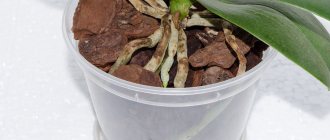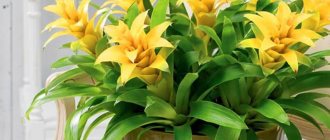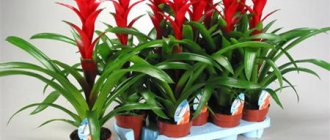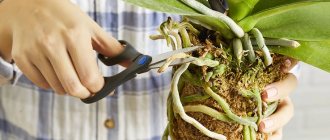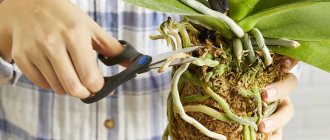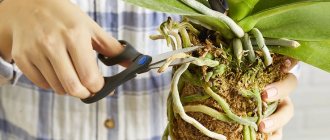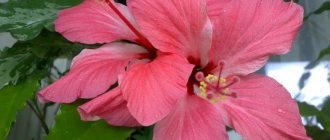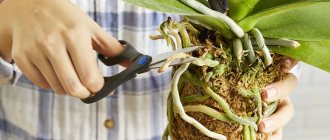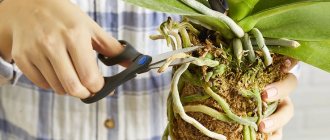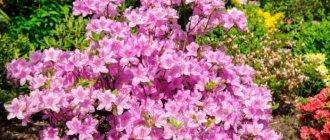How to determine that a flower needs replanting
Unlike other houseplants, guzmania does not need to be replanted regularly - unless, of course, you plan to propagate it. For the flower to feel good, just one change of place of growth will be enough - immediately after purchase, and in the future the slowly developing root system will allow it to continue to be in the existing container.
Important! Most often, stores sell already flowering guzmanias, which means that after about six months the apical part will dry out and the plant will wither, losing all its decorative effect. In order not to be left with nothing, it is better to prepare in advance a sufficient number of children, who will later decorate the home.
When Guzmania reproduces, its babies are transplanted into a separate pot, which appear immediately after the mother bush blooms (begins and ends in the summer). Within 2–4 months after emergence, they form their own root system, so when they reach 15 cm, they are separated from the “mother” and transferred to a separate container.
How to propagate Guzmania yourself?
The “baby” of the plant is formed during its flowering.
The time comes, and the plant itself dies, and by this time the young shoot has already reached 10-15 cm. It is important that the “baby” already has roots by this time, so that it can develop separately in another pot. Thus, the death of the mother plant is a regularity of its development cycle
The small plant is carefully cut with a sharp knife, after which it is transplanted into special soil. This plant will bloom no sooner than in a year.
In order for flowering to occur faster, you need to create ideal care for guzmania at home: it is necessary to provide high temperature, bright lighting, and the use of special fertilizer for young plants.
There is a way in which you can achieve flowering of a small guzmania at almost any time. A kind of greenhouse is created for the plant: they put it in a bag and put a ripe banana (or an apple) in a pot, which, when rotting, begins to release a substance that accelerates flowering. Rotting fruits can be replaced with fresh ones. And so on until the first bracts appear.
When can Guzmania be replanted?
In terms of replanting, guzmania cannot be called a very capricious plant, but, as when growing other indoor flowers, it is advisable to postpone this process to spring, when the root system of the emerging children is fully formed. In the fall, you can replant plants that are in shipping pots, because after purchase they will not be able to develop for a long time in such conditions. In other cases, you should wait to transplant until spring.
Signs and superstitions about Guzmania
People look for hidden meaning in everything, and beliefs about the power of guzmania are no exception. The plant is believed to:
- It is a natural aphrodisiac, supporting male sexual activity. Therefore, it is often placed closer to the bed.
- Taking into account the first property, the beauty is credited with powerful positive energy, the ability to bring happiness to the home, and strengthen family relationships.
- Guzmania brings harmony to the home, improves mood, and promotes mental peace.
This is such a complex flower with many positive properties that you should definitely place on your windowsill. Guzmania symbolizes harmony, happiness, masculine strength and prosperity. In view of the above, it is an excellent gift for any holiday.
Preparing for transplant
Preparations in almost all cases involve the same actions: purchasing a suitable pot, preparing the soil substrate and drainage layer. However, in the case of guzmania, an important step will be additional processing of the plant itself.
Choosing a pot
Guzmania is characterized by a shallow root system, which means that the pot for it should be low but wide. Deep containers can lead to rotting of the lower part of the substrate, to which the roots of the flower simply do not grow. The ideal option would be a pot no more than 12 cm high, and the bottom 2-3 cm should be occupied by a drainage layer.
Find out how to properly plant indoor flowers in a pot.
The diameter of the planting container is selected based on the size of the children being planted, but on average it is no more than 10 cm. When transplanting from a transport container of an adult plant, this value can be increased by half, and sometimes more.
Drainage preparation
The height of the drainage layer in a pot with guzmania is usually 1/3 of the total height of the product, and expanded clay, foam plastic or charcoal can be used as a moisture-absorbing material. The latter option is even more preferable, since it is an excellent prevention of high soil acidity and prevents the development of infection, while simultaneously protecting the plant from waterlogging and associated putrefactive processes.
As for the soil mixture, it should be as close as possible to the natural substrate of Guzmania. In nature, the flower often grows not in the ground, but on old wood, so you either plant it in ready-made soil for bromeliad crops, with the addition of peat, sphagnum moss and loose leaf soil, or prepare the soil mixture yourself using one of the following recipes:
- Option 1. A mixture of crushed roots of sphagnum moss and ferns (in a ratio of 1:3).
- Option 2. A mixture of coniferous bark, moss, sand and leaf soil in a ratio of 2:1:1:2.
- Option 3. A mixture of humus, sand, turf soil and peat, in a ratio of 2:1:2:4.
For any of them, it would be appropriate to use crushed charcoal, with the help of which you can increase the looseness of the substrate, even when you are already using it as a drainage layer.
Did you know? In its natural habitat, guzmania can be found in the West Indies, Florida, Venezuela, Brazil and central America. The local population has long considered the flower a symbol of the male gender, believing that being close to men, it is able to maintain their vigor and even prolong their life.
Flower processing
Treatment of guzmania before transplantation is one of the main stages of the preparatory process, and it does not matter for what purpose it is performed. If we are talking about an adult, recently acquired plant, then before placing it in a new pot it would be wise to remove all damaged roots and treat the cut areas with crushed activated carbon, which will subsequently prevent rotting of the root system. The rhizome of children separated from the mother bush can be treated with a growth stimulant, using one of the popular drugs: for example, “Kornevin” or “Heteroauxin”.
Drainage and soil
For drainage, use pieces of polystyrene foam and tree bark, coal, and expanded clay. Coal prevents soil acidification and the spread of infections in it.
The soil sold in all flower shops is excellent for guzmanias. The special substrate for bromeliads includes peat, sphagnum moss, pieces of bark and loose leaf soil.
You can add conifer needles, charcoal - all this will make the soil even lighter and looser - this is exactly what all bromeliads need.
How to replant a plant at home: step-by-step instructions
Depending on what part of the plant you are going to replant, this process will have certain differences, but in any case you will need the following tools:
- a sharp knife (used to cut off children from the mother bush or remove damaged roots of an adult plant);
- shovel for pouring soil;
- growth stimulator for treating the root system (for example, “Kornevin”);
- landing capacity.
An adult plant can be moved to a new pot using the transfer method, after slightly drying the old soil. There is nothing difficult about this, the main thing is to prepare a suitable soil mixture and a larger pot.
Transplanting children will be more interesting and responsible, so it is advisable to adhere to the following plan of action:
- To begin, remove the mother plant from the pot and carefully remove the root system of the selected Guzmania babies from the old substrate (most often you have to use a knife to separate it).
- Place them on a clean sheet of paper and leave to dry for about an hour. Treat the roots with the prepared solution for better rooting.
- Place a drainage layer in the new pot so that it takes up one third of the total available space.
- Make a small mound of soil and place the root rosette of the plant to be planted in the center.
- Carefully level the roots and sprinkle them with soil substrate, up to the level of the root collar.
- Lightly compact the soil and spray it with settled water from a spray bottle.
Important! There is no need to flood
the plant immediately after transplanting.
In order to absorb moisture well, its roots must first take root in the new environment. At this point, the transplantation of guzmania can be considered complete and all that remains is to move the pot to a suitable place, further providing appropriate care for the rapid rooting of the young flower.
Video: features of development and transplantation of Guzmania
Main types of Guzmania
Thanks to the science of selection, almost 200 species of Guzmania have been bred around the world. Their difference is in the color of the bract, flower or leaf blade. Some of them live in the ground, others on old driftwood, even on the slopes of rocks. The following species mainly predominate in home cultivation:
- Tempo Extra. An evergreen crop most often sold in flower shops. The foliage is bright green with a golden tint. The bract is red. It blooms for a long time and is not difficult to care for.
- Ostara. A plant with smooth narrow leaves in a lush rosette. Blooms from late winter to early autumn. After flowering it dies, but in the place of the mother plant several daughter bushes remain, which after transplantation are capable of independent life.
- Lingular guzmania. One of the most popular varieties. The bright bract of short stipules can be purple, orange, red or white. The leaf is rich green, spreading, collected in a strong rosette.
- Minor Rondo. A small bush with narrow short green or variegated leaves. The bract is red or orange. After dying, it leaves daughter sprouts.
- Hilda. A large plant, can grow up to 70 cm. The leaves are light, slightly pointed at the ends. The bract is low, the rosette is loose. The top stands out with a bright lemon color. Blooms for at least 4 months.
- Mosaic. An annual crop with a beautiful, lush, spreading rosette of long leaves. Stipules with sharp ends have an elliptical shape of bright pink color. The flowers in the stipules are light yellow.
Note! Gardeners practice growing a mix. This is not a separate variety
The name refers to several varieties in one container. They are placed so as to obtain bright and varied flowering from bushes of several colors.
Guzmania mix is several varieties of different colors in one container
Features of care after transplantation
Correctly performed transplantation is only half the battle on the way to obtaining a beautiful and blooming guzmania flower, therefore, so that all the efforts made are not in vain, be sure to take into account several requirements for further care.
Location and optimal conditions of detention
Regardless of the season, the transplanted plant should always be placed in a fairly warm room with moderate lighting and no drafts. However, specific temperature conditions and air humidity in summer and winter will have their differences, so when organizing conditions for the growth and development of Guzmania, you should focus on the following indicators:
| Season | Lighting | Temperature | Humidity |
| Winter | Moderately bright, but without exposure to direct sunlight | +18…20°C | Not lower than 60%, for which it is better to place the flower away from heat sources |
| Spring | +19…+21°C | 65–75% | |
| Summer | Moderate, with protection from direct sunlight in the afternoon | +21…+25°C | 75–80% |
| Autumn | +20…+22°C | 65–75% |
With the arrival of cold weather and the beginning of the use of various heat sources, it is quite difficult to maintain air humidity at the required level, so a pot of guzmania is often placed on a stand with moistened moss or expanded clay laid on it. It will also be beneficial for the plant to place the pot next to an aquarium or a humidifier.
Watering and fertilizers
On the first day after transplanting the flower, it will be enough to thoroughly wet the soil in the pot and add a small amount of liquid to the outlet. In this case, the liquid used must be soft, filtered and relatively warm, for which the water in an open container is left in the room for a day. Hard cold water straight from the tap is detrimental to the plant, especially since in this case the liquid is applied not into the soil, but into the rosette formed by the leaves, filling it to 2/3 of the total volume.
Important! The water remaining in the outlet after watering must be drained or removed with a blotting cloth, otherwise the increased humidity will cause the plant to rot.
.
In summer, it is enough to moisturize guzmania once every two days, and in winter - no more than once a week. Fertilizers for Guzmania are not a vital component of care, since in its natural habitat it receives nutrients in minimal quantities. However, by feeding indoor flowers at home, you can not only stimulate flowering, but also prolong it, which will allow you to admire the plant for 2-3 weeks longer than usual.
To fertilize the exotic beauty, you can use universal compounds developed to enhance the decorative properties of flowering plants (for example, Agricol, Stimovit, Biopon). Before adding to the soil, any of them must be dissolved in water, which will help avoid overfeeding the plant. Moreover, in the case of guzmania, a single dosage should be approximately 4-5 times lower than that recommended by the manufacturer. Treatment of plants with the prepared mixture is carried out from May to September, no more than once a month.
Flower propagation
Propagation of Guzmania can be done in one of two ways: using purchased seed material or by separating the children formed on a dying mother plant. If you purchased an already mature flower, be prepared for the fact that you will soon have to take care of its renewal, because the average lifespan of this plant is 2-3 years, and some specimens die off much earlier.
Did you know? Guzmania and Guzmania are the same plant, and the latter version of the name is even more correct, since the flower was named after the Spanish scientist Guzman. The letter “z” appeared when translating the word “Guzmania” from Latin.
In any case, with proper cultivation, new specimens (“babies”) always grow next to the mother plant, which need to be moved to a separate container. When propagating guzmania by seed, purchased seeds must first be disinfected in a weak solution of potassium permanganate, and then sown in small containers filled with a mixture of peat and sand (in equal proportions).
Germination of seeds is carried out in a warm room, with a stable temperature of at least +25°C and high humidity, which can be achieved by covering the seedlings with oilcloth and regularly spraying the soil with water from a spray bottle. Usually the first sprouts appear after three weeks, and after another 7 days they will need to be picked into separate cups. If all actions are performed correctly, then the emerging seedlings will quickly catch up with the planted children.
Video: Guzmania propagation
Caring for young plants
After replanting, the first watering is plentiful, a lump of earth is soaked and water is poured into the outlet. In this case, the water should be soft, filtered and settled for two days. Watering with hard water is detrimental to Guzmania. It does not require magnesium and calcium salts.
The pot is first placed in a shaded place, after 1-2 weeks it is installed in a permanent place. Shelter at this moment is no longer needed. It is better to replant the plant in the spring, but if necessary, you can at any time. The main thing is to wait for the development of the root system, which could give viability to the plant.
In nature, plants grow in colonies and very densely, creating clumps of plants of all generations. At home, thickening can lead to a lack of flowering. Plants are demanding on the level of illumination. Therefore, it is optimal to plant each guzmania in a separate bowl.
How to separate Guzmania babies - video
Typical mistakes during transplantation
By paying attention to some important details of transplantation and further care of guzmania, you will be able to avoid many problems.
Check out the houseplant Billbergia.
First of all, we are talking about this:
- Lack of flowering of the plant, which is explained by a lack of moisture, heat or light. To prevent this, children planted in pots should be placed only in a well-lit place, with a suitable temperature and humidity (shown in the table above).
- Rotting of Guzmania immediately after transplantation or during further cultivation. In any case, the main reason for this phenomenon lies in the excessive amount of moisture due to frequent watering and spraying.
- Death of young shoots. If the transplanted plant looks lethargic and soon dies, check the temperature in the room. Typically, such consequences result from prolonged exposure of the flower to temperatures below +12…+13°C.
- Short flowering. The occurrence of this problem is often explained by moisture getting on the opened flower petals, so when watering guzmania during the flowering period, it is advisable to add it to the root.
- Slow growth of the transplanted shoot. Be sure to monitor the quality of water used for irrigation. The slightest admixture of chlorine or low temperature of the liquid will negatively affect development.
- Infection with infectious diseases. If the first signs of the disease became noticeable soon after transplanting the guzmania, then it is likely that it was caused by a violation of sanitary standards when pruning children or when preparing the soil.
- Drying of the transplanted parts. The main reason that plants do not take root in a new place of growth is their lack of a sufficiently developed root system. Simply put, you can separate them from the mother bush only if there are a large number of clearly visible roots.
- Drying leaf tips. Perhaps the indoor air is too dry and young plants need more frequent spraying.
Although these are not all, they are the most common problems with guzmania, so every gardener should know about them. To normalize the condition of a flower, it is enough to review the conditions created for it and make appropriate adjustments. In extreme cases, you will have to replant the plant again without repeating previous mistakes.
How to care for guzmania (video)
It is very important to remember that the root system of any type of guzmania is very fragile, so compacting the soil in a flower pot is strictly forbidden. After planting, abundant watering is carried out, and, if necessary, nutrient soil is added. Watering the planted plant is carried out in the leaf rosette with settled water at room temperature with the addition of a few drops of “Kornevin”. Further care of the plant consists of watering, fertilizing, and also carrying out preventive measures.
